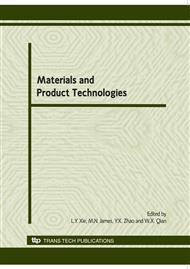p.836
p.841
p.846
p.851
p.855
p.860
p.866
p.871
p.876
Computational Analysis of Condensed Vaporized Alloying Elements of 5456 Aluminum Alloy
Abstract:
A lot of research has been done regarding the vaporization rates of alloying elements in general. However, not as much has been done on vaporized alloying element condensates. This paper investigates the drop wise pattern under a controlled thermal environment using some existing models with a few modifications to suit experimental results. From the analysis it was found that the condensation factors for Mg2+ and Al+ ions were 0.7 and 0.98 respectively. These results show that Mg2+ ions are more volatile than Al+ , and that any ions left which are usually unaccounted for would usually have been lost to spatter, or alternatively absorbed by the plasma ions within the laser welding environment. The conduction mode of heat transfer was found to be a dominant factor especially in the vicinity of the cooler regions of the metal. A vapor temperature of 2537oC was also calculated. This amounted to about 2% more than the expected boiling temperature. This paper has effectively and quantitatively analyzed the condensation process of 5456 aluminum alloy. It explicitly elucidated the approximate values of vaporized alloying elements and clearly shows how their molecular weights were affected by temperature.
Info:
Periodical:
Pages:
855-859
Citation:
Online since:
June 2010
Authors:
Price:
Сopyright:
© 2010 Trans Tech Publications Ltd. All Rights Reserved
Share:
Citation:


